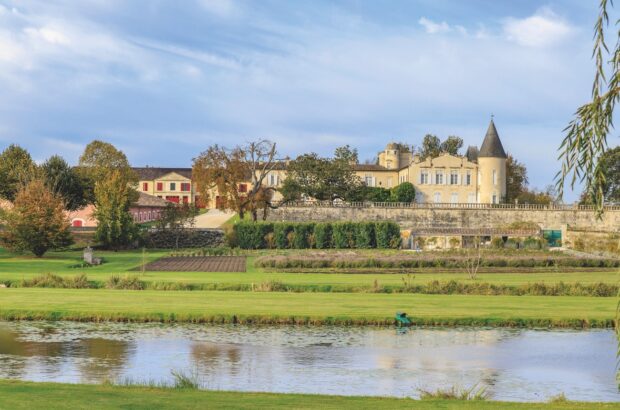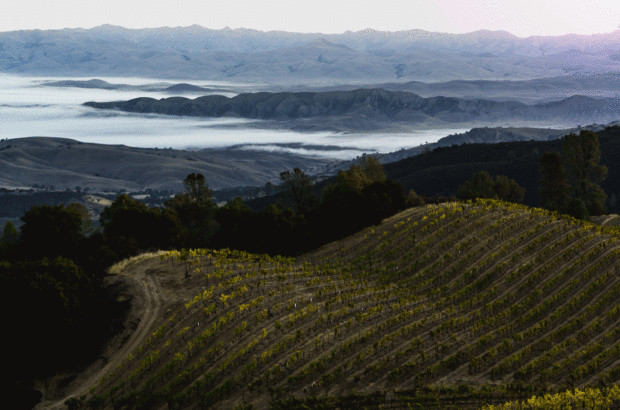Where do we start with Chateau Musar? Well, in the beginning …
In the beginning …
… but which beginning? Where do we start with Chateau Musar? Perhaps with the book of Hosea, written in the eighth century BCE, which tells those Israelites prepared to return to righteousness that they shall “grow as the vine: the scent thereof shall be as the wine of Lebanon” (14.7). Lebanese wine was known as Bibline, after the city of Byblos (modern-day Jbaïl); it was fragrant enough to merit export to Greece. That practical Boeotian farmer Hesiod (we learn from ll. 588-94 of Works and Days, probably written about the same time as Hosea) liked nothing more in midsummer than a picnic.
{"content":"PHA+4oCmIGF0IHRoaXMgdGltZSxJIGxvdmUgYSBzaGFkeSByb2NrLCBhbmQgQmlibGluZSB3aW5lLEEgY2FrZSBvZiBjaGVlc2UsIGFuZCBnb2F04oCZcyBtaWxrLCBhbmQgc29tZSBtZWF0PC9wPgo8cD5PZiBoZWlmZXJzIHBhc3R1cmVkIGluIHRoZSB3b29kcywgdW5jYWx2ZWQsPC9wPgo8cD48ZGl2IGNsYXNzPSJhZC1jb250YWluZXIgYWQtY29udGFpbmVyLS1tb2JpbGUiPjxkaXYgaWQ9InBvc3QtaW5saW5lLTIiIGNsYXNzPSJpcGMtYWR2ZXJ0Ij48L2Rpdj48L2Rpdj48L3A+CjxwPk9yIGZpcnN0LWJvcm4ga2lkcy4gVGhlIG1heSBJIHNpdCBpbiBzaGFkZTwvcD4KPHA+QW5kIGRyaW5rIHRoZSBzaGluaW5nIHdpbmUsIGFuZCBlYXQgbXkgZmlsbDwvcD4KPHA+QW5kIHR1cm4gbXkgZmFjZSB0byBtZWV0IHRoZSBmcmVzaCBXZXN0IFdpbmQg4oCmPC9wPgo8ZGl2IGNsYXNzPSJhZC1jb250YWluZXIgYWQtY29udGFpbmVyLS1tb2JpbGUiPjxkaXYgaWQ9InBvc3QtaW5saW5lLTMiIGNsYXNzPSJpcGMtYWR2ZXJ0Ij48L2Rpdj48L2Rpdj4KPGhyPgo8aDI+Q2hhdGVhdcKgTXVzYXI8L2gyPgo8cD5QZXJoYXBzLCB0aG91Z2gsIHdlIHNob3VsZCBmYXN0LWZvcndhcmQgYWxtb3N0IDMwIGNlbnR1cmllcywgdG8gYSBtb21lbnQgd2hlbiBldmVyeSB2aWxsYWdlIGluIExlYmFub24gaGFkIGEgZmV3IHJvd3Mgb2YgdmluZXMgZm9yIHRhYmxlIGdyYXBlcyBhbmQgYXJhayDigJMgYnV0IG5vIG1vcmUuIE5vIG1vcmUsIHRoYXQgaXMsIHVudGlsIGEgbWFuIGNhbGxlZCBHYXN0b24gSG9jaGFyIGRlY2lkZWQsIGluIDE5MzAgb3Igc28sIHRoYXQgaGlzIGNvdW50cnkgc2hvdWxkIHJlLWVzdGFibGlzaCB0aGUgZmluZSB3aW5lIGluZHVzdHJ5IG9mIGFuY2llbnQgZGF5cywgYW5kIHRoYXQgaGUgd2FzIHRoZSBtYW4gdG8gZG8gaXQuIE9yIHBlcmhhcHMgdGhlIGJlZ2lubmluZyBpcyByZWFsbHkgMTk1OSwgd2hlbiB0aGUgMTk1NiB3aW5lIG1hZGUgYnkgR2FzdG9uIHdhcyBib3R0bGVkIGJ5IGhpcyBzb24gU2VyZ2UgSG9jaGFyIChwaWN0dXJlZCksIGEgdGhvdWdodGZ1bCBjaXZpbCBlbmdpbmVlcmluZyBzdHVkZW50IHdobywgZml2ZSB5ZWFycyBlYXJsaWVyLCBoYWQgd2FudGVkIHRvIGRpZS4gKOKAnEkgd2FzIG5ldmVyIGRlcHJlc3NlZC4gQnV0IEkgY291bGRu4oCZdCB1bmRlcnN0YW5kIHdoeSBJIHdhcyBhbGl2ZS4gV2luZSB3YXMgYSB2ZXJ5IHNhdGlzZmFjdG9yeSBhbnN3ZXIgdG8gbXkgcXVlc3Rpb24uIEl0IHdhcyBpbmRpcmVjdGx5IGFuIGFuc3dlciB0byB0aGUgbXlzdGVyeSBvZiBleGlzdGVuY2Uu4oCdKSBJdCBpcywgYWZ0ZXIgYWxsLCB0aGUgNDQgdmludGFnZXMgbWFkZSBzaW5jZSB0aGVuIGJ5IFNlcmdlIEhvY2hhciB3aGljaCBoYXMgZGVmaW5lZCBMZWJhbmVzZSB3aW5lIGluIHRoZSBtb2Rlcm4gZXJhLjwvcD4KPHA+SW4gb3RoZXIgd2F5cywgdGhvdWdoLCB0aGUgYmVnaW5uaW5nIGlzIDE5NzIsIHdoZW4gdGhlIGZpcnN0IHNob3RzIHdlcmUgZmlyZWQgaW4gYSBjaXZpbCB3YXIgdGhhdCB3YXMgdG8gbGFzdCwgaW50ZXJtaXR0ZW50bHksIGZvciAyMCB5ZWFycyBhbmQgZGVzdHJveSBtdWNoIG9mIEJlaXJ1dC4gVXAgdW50aWwgdGhhdCB0aW1lLCBMZWJhbm9uIGhhZCBjb25zdW1lZCBldmVyeSBkcm9wIG9mIE11c2FyLCBidXQgd2l0aCB0aGUgY29taW5nIG9mIHdhciBTZXJnZSBIb2NoYXIgbG9zdCA5MCBwZXIgY2VudCBvZiB0aGF0IGhvbWUgbWFya2V0LiBIZSBoYWQgdG8gc2VsbCBhYnJvYWQgdG8gc3Vydml2ZS4gQW5kIGluIHRoYXQgcGFydGljdWxhciByZXNwZWN0IHRoZSBiZWdpbm5pbmcgd291bGQgYmUgdGhlIEJyaXN0b2wgV2luZSBGYWlyIG9mIDE5Nzkgd2hlcmUsIGRlc3BpdGUgdGhlIGNsYW1vdXIgb2Ygc2NlbnQgYW5kIGZsYXZvdXIgZnJvbSB0aGUgYmVzdCBvZiBFdXJvcGUsIGJvdGggYXVjdGlvbmVlciBhbmQgdGFzdGVyIE1pY2hhZWwgQnJvYWRiZW50IGFuZCBqb3VybmFsaXN0IFJvZ2VyIFZvc3MgcGlja2VkIG91dCBNdXNhciAxOTY3IGFzIHRoZSBkaXNjb3Zlcnkgb2YgdGhlIEZhaXIuPC9wPgo8ZGl2IGNsYXNzPSJhZC1jb250YWluZXIgYWQtY29udGFpbmVyLS1tb2JpbGUiPjxkaXYgaWQ9InBvc3QtaW5saW5lLTQiIGNsYXNzPSJpcGMtYWR2ZXJ0Ij48L2Rpdj48L2Rpdj4KPHA+VGhlcmUgYXJlLCBpbiBicmllZiwgbm8gZW5kIG9mIGJlZ2lubmluZ3MsIGFuZCBub3RoaW5nIGNvdWxkIGJlIG1vcmUgYXBwcm9wcmlhdGUgZm9yIHRoZSBMZWJhbm9uLiBXaGVuIEkgZmlyc3Qgd2VudCB0aGVyZSBpbiAxOTkzLCBJIHJlbWVtYmVyIGEgcG9zdGVyIG9mIEJlaXJ1dCBwaW5uZWQgdG8gdGhlIHdhbGwgb2YgdGhlIExvbmRvbiB2aXNhIG9mZmljZS4gTWlsbGUgZm9pcyBtb3J0ZSwgaXQgcmVhZCwgbWlsbGUgZm9pcyByZXbDqWN1ZS4gYEEgdGhvdXNhbmQgdGltZXMgZGVhZCwgYSB0aG91c2FuZCB0aW1lcyByZWJvcm7igJkuIEkgam90dGVkIGl0IHRoZSB3b3JkcyBkb3duIGluIG15IHBhc3Nwb3J0LiBJbiB0aGUgbGFzdCAxMCB5ZWFycyBvZiBmcmFudGljIHJlYnVpbGRpbmcsIHRoZSBjaXR5IGhhcyBhY2hpZXZlZCBhbm90aGVyIHJlYmlydGg6IGl0IGlzIG5vdyBhcyBub2lzeSwgYnJpZ2h0IGFuZCBicmFzaCBhcyBhdCBhbnkgdGltZSBpbiB0aGUgcGFzdC4gWW91IGNvdWxkIHNlZSB0aGUgbW9vbmxpZ2h0IHNoaW5lIG9uIHRoZSBydWluZWQgd2FsbHMgb2YgdGhlIGNpdHkgaW4gMTk5Mywgc28gc3BhcnNlIHdlcmUgaXRzIGVsZWN0cmljIGxpZ2h0cy4gSW4gdGhlIG5lb24gZ2xhcmUgb2YgMjAwMywgbm8gY2hhbmNlLjwvcD4KPHA+SWYgeW91IHdhbnQgdG8gdW5kZXJzdGFuZCBNdXNhciwgbm9uZSBvZiB0aGlzIGlzIGlycmVsZXZhbnQuIFRoZSBmYWN0IHRoYXQgTGViYW5lc2Ugd2luZSB3YXMgZmFtb3VzbHkgZ29vZCAzMCBjZW50dXJpZXMgYWdvLCBhbmQgdGhhdCBldmVyeSB0aW1lIGFuIEFuY2llbnQgam90dGVkIGRvd24gYSB0YXN0aW5nIG5vdGUgZm9yIGl0IHRoZXkgbWVudGlvbmVkIGBmcmFncmFuY2XigJkgb3IgYHNjZW504oCZLCBoZWxwcyB0byBleHBsYWluIHdoeSBNdXNhciBjb21tYW5kcyBzdWNoIGVudGh1c2lhc20gYXJvdW5kIHRoZSB3b3JsZCB0b2RheS4gTGlrZSBhbGwgZ3JlYXQgd2luZXMsIGl0IGlzIHJlbWFya2FibHkgcGVyc2lzdGVudCBpbiB0aW1lLCBkZXNwaXRlIGV2ZXJ5IGFwcGVhcmFuY2UgdG8gY29udHJhcnk7IHRoYXQgMTk2NyB3aGljaCBzbyBpbXByZXNzZWQgTWljaGFlbCBCcm9hZGJlbnQgc3RpbGwgbWVyaXRlZCBmb3VyIHN0YXJzIGZyb20gaGltIHdoZW4gdGFzdGVkIGluIDIwMDAuIFdoZW4gU2VyZ2UgdGFsa3MgYWJvdXQgbGlmZSBpbiB0aGUgTGViYW5vbiwgaGUgYWx3YXlzIHVzZXMgdGhlIHdvcmQg4oCcY2hhb3PigJ0uIFlldCB0aGUgcGxhY2Ugd29ya3MgYW5kIHRocml2ZXMuIEl0IGlzIGxpa2Ugbm93aGVyZSBlbHNlIGFuZCBub3RoaW5nIGVsc2UuIERpdHRvIGZvciBNdXNhciwgYSB3aW5lIG1hZGUgZnJvbSBhIGNoYW90aWMgYW5kIGltcHJvYmFibGUgYmxlbmQgb2YgZ3JhcGVzIGJ5IHNvbWV0aW1lcyBwZXJ2ZXJzZSBhbmQgZGFuZ2Vyb3VzIG1ldGhvZHMg4oCTIGJ1dCB3aGljaCBoYXMgZ2l2ZW4gdGhvc2Ugd2hvIGtub3cgaXQgc29tZSBvZiB0aGVpciBtb3N0IHN1YmxpbWUgZXhwZXJpZW5jZXMgb2YgZHJpbmtpbmcgZnVsbHkgbWF0dXJlLCBmdWxseSByaXBlIHJlZCB3aW5lIGZyb20gYSB1bmlxdWUgYW5kIGFuY2llbnQgdGVycm9pci48L3A+CjxkaXYgY2xhc3M9ImFkLWNvbnRhaW5lciBhZC1jb250YWluZXItLW1vYmlsZSI+PGRpdiBpZD0icG9zdC1pbmxpbmUtNSIgY2xhc3M9ImlwYy1hZHZlcnQiPjwvZGl2PjwvZGl2Pgo8cD5VbmRlcnN0YW5kaW5nIHJlcXVpcmVzIGZhY3RzLCBzbyBoZXJlIGFyZSBzb21lLiBNdXNhciBwcm9kdWNlcyBuaW5lIHdpbmVzOiB0aHJlZSByZWRzLCB0aHJlZSB3aGl0ZXMgYW5kIHRocmVlIHJvc8Opcy4gKEFyYWssIHRvby4pIEluIGVhY2ggY2FzZSwgdGhlIHRvcCB3aW5lIGlzIGNhbGxlZCBDaMOidGVhdSBNdXNhciBhbmQgdGhlIHNlY29uZCB3aW5lIChmb3IgeW91bmdlciBkcmlua2luZykgQ3V2w6llIFLDqXNlcnbDqWUuIFRoZXJlIGlzIHRoZW4gYW5vdGhlciB3aW5lLCBvZiBkaWZmZXJlbnQgc3R5bGUsIGNhbGxlZCBIb2NoYXIgUMOocmUgZXQgRmlscy4gTXVzYXIgaGFzIDUwIGhhIG9mIGl0cyBvd24sIGFuZCBjb250cm9scyBhIGZ1cnRoZXIgODAgaGE7IGEgc3VwcGxlbWVudGFyeSA1MCBoYSBhcmUgYmVpbmcgcGxhbnRlZCBhdCBwcmVzZW50IGZvciB0aGUgQ3V2w6llIFLDqXNlcnbDqWUsIHdpdGggYSBwbGFuIGZvciBhIGZ1cnRoZXIgNTAgaGEgaW4gdGhyZWUgeWVhcnMgaWYgYWxsIGdvZXMgd2VsbC48L3A+CjxwPlRoZSByZWQgYW5kIG1vc3Qgb2YgdGhlIHJvc8OpIHdpbmUgaXMgZ3Jvd24gaW4gdGhyZWUgdmlsbGFnZXMgb24gdGhlIHdlc3Rlcm4gc2lkZSBvZiB0aGUgdGhlIEJla2FhIHZhbGxleSwgb24gdGhlIGZvb3RoaWxscyBvZiB0aGUgZXh0ZW5kZWQgTW91bnQgTGViYW5vbi4gTXVzYXLigJlzIG93biA1MCBoYSBvZiByZWQgZ3JhcGVzIGFyZSBpbiB0aGUgdmlsbGFnZSBvZiBLZWZyYXlhIChvbiBhIHZhcmlldHkgb2Ygc29pbHM6IHNvbWV0aW1lcyBzdG9ueSwgc29tZXRpbWVzIHdpdGggbW9yZSBjbGF5IGFuZCBzYW5kLCBvdmVyIGEgbGltZXN0b25lIGJhc2UpLCB3aGlsZSB0aGUgdmluZXlhcmRzIGl0IGNvbnRyb2xzIChidXQgZG9lc27igJl0IG93bikgYXJlIGluIHRoZSBuZWlnaGJvdXJpbmcgdmlsbGFnZXMgb2YgQcOibmEgKGRlZXBlciBzb2lscyBvdmVyIGxpbWVzdG9uZSkgYW5kIEFtbWlxIChncmF2ZWxzIG92ZXIgbGltZXN0b25lKS4gVGhlIEJla2FhIGlzIGhpZ2g6IHRob3NlIHZpbmV5YXJkcyBhcmUgc2l0ZWQgYmV0d2VlbiA5MDBtIGFuZCAxMDUwbSBhYm92ZSBzZWEgbGV2ZWwuIEFjY29yZGluZyB0byBTZXJnZSwgdGhlIGhlaWdodCBnaXZlcyB0aGVtIGEgY2xpbWF0ZSBlcXVpdmFsZW50IG9mIHRlbiBwYXJhbGxlbHMgZnVydGhlciBub3J0aC4gVGhleSBsaWUgYXQgMzPCsDsgc28gNDPCsCB3b3VsZCBtYWtlIHRoZW0gdGhlIGVxdWl2YWxlbnQgb2YgQm9yZGVhdXggJiM4MjEyOyDigJxleGNlcHQgd2UgaGF2ZSBsZXNzIHJhaW4gYW5kIG1vcmUgc3Vuc2hpbmXigJ0uIE11c2Fy4oCZcyB3aGl0ZSBncmFwZXMsIGJ5IGNvbnRyYXN0LCBhcmUgZ3Jvd24gaW4gdHdvIHZlcnkgZGlmZmVyZW50IGxvY2F0aW9uczogb25lIDEwLWhhIHZpbmV5YXJkIGluIHNpdGVkIGFjcm9zcyB0aGUgQmVrYWEgdmFsbGV5IG9uIHRoZSBmb290aGlsbHMgb2YgdGhlIEFudGktTGViYW5vbiBtb3VudGFpbnMsIGluIGEgdmlsbGFnZSBjYWxsZWQgQWluIEFyYWIgKGF0IDE0MDBtLCBvbiBzdG9ueSBjaGFsayBzb2lscyksIGFuZCB0aGUgb3RoZXIgNS1oYSB2aW5leWFyZCBpcyBzaXRlZCBvbiB0aGUgc2Vhd2FyZCBzaWRlIG9mIE1vdW50IExlYmFub24sIGluIGEgdmlsbGFnZSBzaXRlZCBhdCAxNTAwbSBhYm92ZSBzZWEgbGV2ZWwgY2FsbGVkIEJhcWHDonRhIChvbiBjYWxjYXJlb3VzIGdyYXZlbHMpLjwvcD4KPHA+Rm9yIENow6J0ZWF1IE11c2Fy4oCZcyByZWQsIFNlcmdlIHVzZXMgdmFyeWluZyBwcm9wb3J0aW9ucyBvZiB0aHJlZSByZWQgZ3JhcGVzOiBwcm9kaWdpb3VzbHkgcGVyZnVtZWQgQ2luc2F1bHQsIHJpY2ggYW5kIHNwaWN5IDxhIGhyZWY9Imh0dHBzOi8vd3d3LmRlY2FudGVyLmNvbS93aW5lL2dyYXBlLXZhcmlldGllcy9jYXJpZ25hbi8iIHRhcmdldD0iX2JsYW5rIiByZWw9Im5vb3BlbmVyIG5vcmVmZXJyZXIiPkNhcmlnbmFuIDwvYT4oZmFyIHJpY2hlciB0aGFuIHRoaXMgdmFyaWV0eSBldmVyIGlzIGluIHRoZSBMYW5ndWVkb2MpIGFuZCBkZW5zZSB5ZXQgc3VjY3VsZW50IDxhIGhyZWY9Imh0dHBzOi8vd3d3LmRlY2FudGVyLmNvbS93aW5lL2dyYXBlLXZhcmlldGllcy9jYWJlcm5ldC1zYXV2aWdub24vIiB0YXJnZXQ9Il9ibGFuayIgcmVsPSJub29wZW5lciBub3JlZmVycmVyIj5DYWJlcm5ldCBTYXV2aWdub248L2E+LiBJbiB0aGUgYE11c2FyIE1hbuKAmSwgYXMgU2VyZ2UgcHV0cyBpdCwg4oCcdGhlIENhYmVybmV0IFNhdXZpZ25vbiBpcyB0aGUgc2tlbGV0b24sIHRoZSBiYWNrYm9uZSwgd2hpY2ggSSBoaWRlIHdpdGggdGhlIG11c2NsZXMsIHdoaWNoIGNvbWUgZnJvbSB0aGUgQ2FyaWduYW4sIGFuZCB0aGUgc2tpbiwgd2hpY2ggaXMgdGhlIENpbnNhdWx04oCdLiBPdGhlciBncmFwZXMgY29tZSBhbmQgZ28gb24gYW4gZXhwZXJpbWVudGFsIGJhc2lzLCBidXQgbm9uZSBoYXMgZXZlciBmaWd1cmVkIGxhcmdlIGluIHRoZSBibGVuZDogU2VyZ2UgaGFkIHRyaWVkIFN5cmFoIGFuZCBNb3VydsOoZHJlIGJ1dCBpcyBub3cgZGlzY2FyZGluZyB0aGVtOyByZXNlYXJjaCBjb250aW51ZXMgb24gR3JlbmFjaGUgYW5kIE1lcmxvdC4gVGhlIHJlZCBDdXbDqWUgUsOpc2VydsOpZSBpcyBub3cgYSBnZW51aW5lIGBzZWNvbmQgd2luZeKAmSwgYmFzZWQgb24gcGFyY2VscyBmcm9tIHlvdW5nIHZpbmVzIGFuZCBsZXNzIHN1Y2Nlc3NmdWwgbG90czsgdGhlIHJlZCBIb2NoYXIgUMOocmUgZXQgRmlscywgYnkgY29udHJhc3QsIGlzIHByZWRvbWluYW50bHkgYmFzZWQgb24gYSBzaW5nbGUtdmluZXlhcmQgaW4gQcOibmEsIG1vc3RseSBDaW5zYXVsdCBidXQgd2l0aCBhIGxpdHRsZSBDYXJpZ25hbiBhbmQgQ2FiZXJuZXQsIHdoZXJlIHRoZSB2aW5lcyBhcmUgYWxsIG92ZXIgNTAgeWVhcnMgb2xkIGFuZCB5aWVsZHMgYXJlIGxlc3MgdGhhbiAyMCBobC9oYS4gKEluIGdlbmVyYWwgYWxsIHRoZSBNdXNhciB3aW5lcyBhcmUgbWFkZSBmcm9tIHZlcnkgbG93LXlpZWxkaW5nIHZpbmVzLCBvZnRlbiBiZXR3ZWVuIDEwIGFuZCAxNSBobC9oYSwgdGhvdWdoIHRoZXNlIGZpZ3VyZXMgYXJlIHNsaWdodGx5IG1pc2xlYWRpbmcgc2luY2UgcGxhbnRpbmcgZGVuc2l0aWVzIGFyZSB2ZXJ5IGxvdywgdG9vOiBoaXN0b3JpY2FsbHkgYWJvdXQgMSw2MDAgcGxhbnRzIHBlciBoYSwgYW5kIGluIHRoZSBuZXcgcGxhbnRpbmdzIGFib3V0IDMsMjAwIHBsYW50cyBwZXIgaGEuKTwvcD4KPHA+VGhlIGdyYXBlcyBhcmUgaGFuZC1waWNrZWQgYW5kIHRydWNrZWQgNzAga20gdG8gdGhlIHdpbmVyeSBhdCBHaGF6aXIsIHdoaWNoIHRha2VzIGFyb3VuZCA5MCBtaW51dGVzIGZyb20gS2VmcmF5YSAodGhvdWdoIGR1cmluZyB0aGUgQ2l2aWwgV2FyIGl0IGNvdWxkIHRha2UgZGF5cyBvciBldmVuIHdlZWtzOiB0aGUgMTk5MCBoYWQgdG8gbWFrZSBhIDI1MC1rbSBkZXRvdXIsIHdoaWxlIHRoZSAxOTg0IGhhZCB0byB0cmF2ZWwgYnkgc2VhIGFuZCBiZWdhbiBmZXJtZW50aW5nIGVuIHJvdXRlLCBzbyBub25lIHdhcyBldmVyIHJlbGVhc2VkKS4gQm90aCBmZXJtZW50YXRpb25zIHRha2UgcGxhY2UgaW4gY29uY3JldGUgKFNlcmdlIHRyaWVkIGFuZCBhYmFuZG9uZWQgc3RhaW5sZXNzIHN0ZWVsKSB3aXRoIGxvbmcgbWFjZXJhdGlvbnMgb2YgdXAgdG8gZml2ZSB3ZWVrcyBhbmQgZ2VudGxlIGV4dHJhY3Rpb24gdXNpbmcgc29tZSBwaWdlYWdlIGJ1dCBwcmluY2lwYWxseSByZW1vbnRhZ2U7IGFmdGVyIGJldHdlZW4gNiBhbmQgOSBtb250aHMgdGhlIHdpbmVzIGFyZSB0cmFuc2ZlcnJlZCB0byBOZXZlcnMgY2Fza3MgbWFkZSBieSB0aGUgY29vcGVycyBvZiBEZW1wdG9zIChiZXR3ZWVuIGEgcXVhcnRlciBhbmQgb25lLXRoaXJkIG5ldykgZm9yIGJldHdlZW4gMTAgYW5kIDE0IG1vbnRocyDigJxvciB1bnRpbCB0aGUgb2FrIGJlZ2lucyB0byBzaG93LiBXaGVuZXZlciBJIHNtZWxsIG9hayBvbiB3aW5lIEkgYmVnaW4gdG8gZ2V0IGFsYXJtZWQuIFNvbWV0aW1lcyBpdOKAmXMgdGhlIHdyb25nIGFsYXJtLCBidXQgbW9zdGx5IGl04oCZcyB0aGUgcmlnaHQgYWxhcm3igJ0uIFdoZW4gdGhleeKAmXZlIGhhZCBlbm91Z2ggd29vZCwgdGhlIHJlZHMgZ28gYmFjayBpbnRvIGNvbmNyZXRlIGZvciBhbm90aGVyIHllYXIsIGR1cmluZyB3aGljaCB0aGUgZmluYWwgYmxlbmQgKGEgZGVsaWNhdGUgYW5kIHJ1bWluYXRpdmUgb3BlcmF0aW9uIGF0IE11c2FyKSBpcyBhc3NlbWJsZWQuIFRoZXkgYXJlIHRoZW4gYm90dGxlZCwgZ2VuZXJhbGx5IHdpdGhvdXQgZmlsdHJhdGlvbjsgdGhlIGF2ZXJhZ2UgcHJvZHVjdGlvbiBpcyBhcm91bmQgMjUsMDAwIGNhc2VzLjwvcD4KPHA+VGhlIEN1dsOpZSBSw6lzZXJ2w6llIHJlZCAoYXQgcHJlc2VudCA3LDAwMCBjYXNlcyBidXQgd2lsbCByaXNlIHRvIDE1LDAwMCBjYXNlcyB3aXRoIHRoZSBuZXcgcGxhbnRpbmdzKSBzZWVzIG5vIHdvb2QsIGFuZCBpcyBib3R0bGVkIGFmdGVyIHNpeCB0byBlaWdodCBtb250aHM7IHdoaWxlIHRoZSBIb2NoYXIgUMOocmUgZXQgRmlscyByZWQgKDEwLDAwMCBjYXNlcykgaXMgaW4gd29vZCBmb3Igc2l4IHRvIG5pbmUgbW9udGhzLCBhbmQgaXMgYm90dGxlZCBhZnRlciBhYm91dCAxOCBtb250aHMuPC9wPgo8cD5UaGUgd2hpdGVzIGFuZCByb3PDqSB3aW5lcyBhcmUgbGVzcyB3ZWxsLWtub3duLCBtb3Jl4oCZcyB0aGUgcGl0eTogYm90aCBhcmUgdW51c3VhbCBhbmQgc3VwZXJiLiDigJxNeSB3aGl0ZXMs4oCdIHNheXMgU2VyZ2UsIOKAnGFyZSBteSBmaXJzdCByZWRzOyB0aGV5IGFyZSB0byBiZSBzZXJ2ZWQgYXQgcm9vbSB0ZW1wZXJhdHVyZTsgdGhleSB3aWxsIGdvIHdpdGggbW9yZSBmb29kcyB0aGFuIGFueSBvZiBteSByZWRzOyB0aGV5IGFyZSBtb3JlIHNlcmlvdXMgdGhhbiBteSByZWRzOyBhbmQgdGhlaXIgZGltZW5zaW9ucyBhcmUgd2F5IGJpZ2dlciB0aGFuIGFueSBvZiBteSByZWRzLiBCdXQgdGhleSBhcmUgbXVjaCBtb3JlIGRpZmZpY3VsdCB0aGFuIG15IHJlZHMu4oCdIFRoZSBDaMOidGVhdSBNdXNhciB3aGl0ZSBpcyBhIGJsZW5kIG9mIDYwIHBlciBjZW50IGJhcnJlbC1mZXJtZW50ZWQgT2liYWlkZWggKFNlcmdlIG9uY2UgdGhvdWdodCB0aGlzIGEgcHJvZ2VuaXRvciBvZiBDaGFyZG9ubmF5LCBidXQgbm93IGNvbnNpZGVycyBpdCBhIHByb2dlbml0b3Igb2YgQ2hhc3NlbGFzKSBncm93biBpbiBBaW4gQXJhYiwgYW5kIDQwIHBlciBjZW50IGJhcnJlbC1mZXJtZW50ZWQgTWVyd2FoIChjb25zaWRlcmVkIGJ5IFNlcmdlIGEgcHJvZ2VuaXRvciBvZiBTw6ltaWxsb24pIGdyb3duLCB1bmdyYWZ0ZWQsIGF0IEJhcXVhw6J0YS4gVGhlIEN1dsOpZSBSw6lzZXJ2w6llIHdoaXRlIGlzIGF0IHByZXNlbnQgNzAgcGVyIGNlbnQgT2JhaWRlaCwgMjAgcGVyIGNlbnQgTWVyd2FoIGFuZCAxMCBwZXIgY2VudCBVZ25pIEJsYW5jLCB2aW5pZmllZCBpbiBzdGFpbmxlc3Mgc3RlZWwsIGFuZCBTZXJnZSBpcyBzdGlsbCBkZWNpZGluZyB3aGF0IHRvIHVzZSBmb3IgdGhlIEhvY2hhciBQw6hyZSBldCBGaWxzIHdoaXRlIChoZSB0cmllZCBwdXJlIE9iYWlkZWggZmVybWV0ZWQgaW4gc3RhaW5sZXNzIHN0ZWVsIGJ1dCBpdCB3YXMg4oCcdG9vIHNlcmlvdXPigJ0pLiBGaW5hbGx5IHRoZSBDaMOidGVhdSBNdXNhciBSb3PDqSBpcyBhIGJsZW5kIG9mIDkwIHBlciBjZW50IGJhcnJlbC1mZXJtZW50ZWQgd2hpdGUgT2JhaWRlaCBhbmQgMTAgcGVyIGNlbnQgcmVkIENpbnNhdWx0IChTZXJnZeKAmXMgc29mdGx5IG9ha2VkIGFuZCB1bnNwYXJrbGluZyB0cmlidXRlIHRvIHRoZSB0eXBpY2FsIGBibGVuZGVk4oCZIHJvc8OpcyBvZiBDaGFtcGFnbmUsIHdoaWNoIGhlIGxpa2VzKS4gVGhlIEN1dsOpZSBSw6lzZXJ2w6llIFJvc8OpIGFuZCB0aGUgSG9jaGFyIFDDqHJlIGV0IEZpbHMgUm9zw6kgYXJlIGJvdGggYmFzZWQgb24gc2FpZ27DqWVzICh0aGUgYGJsZWVkaW5n4oCZIG9mIHBpbmsganVpY2UgZnJvbSBhIHJlZC13aW5lIHZhdCB0byBjb25jZW50cmF0ZSB0aGUgZmluaXNoZWQgcmVkIHdpbmUpIG9mIENpbnNhdWx0IGZyb20gS2VmcmF5YS48L3A+CjxwPlRoYXTigJlzIGVub3VnaCBmYWN0cy4gSW4gYSB5ZWFyIG9yIHR3bywgbW9yZW92ZXIsIHRoZXkgbWF5IGJlIHdyb25nLiBTZXJnZSBpcyBhIHZlcnkgaW50dWl0aXZlIGFuZCBldm9sdXRpb25hcnkgd2luZW1ha2VyIHdobyBuZXZlciBjZWFzZXMgdG8gc3RvcCwgdGhpbmssIG1vZGlmeSwgY2hhbmdlOyBpbiBhbnkgY2FzZSwgaGlzIG93biBzb24gR2FzdG9uIGluIGluY3JlYXNpbmdseSBydW5uaW5nIHRoZSBidXNpbmVzcyB3aXRoIGxvbmctdGVybSB3aW5lbWFrZXIgVGFyaXEgU2FrciBhbmQgY2VsbGFybWFzdGVyIENoYXJiZWwgQWJpZ2hhbmVtLCB3aGlsZSBTZXJnZSAobm93IDY0KSwgc2F5cyBoZSB3YW50cyB0byDigJxkbyBub3RoaW5n4oCdIGV4Y2VwdCByZWFkLCB3cml0ZSwgdGhpbmsgYW5kIHRhc3RlLjwvcD4KPHA+VW5kZXJzdGFuZGluZyBhbHNvIHJlcXVpcmVzIG1vcmUgdGhhbiBtZXJlIGZhY3RzLiBTZXJnZSBIb2NoYXIgaXMgYSBkZWVwbHkgcGhpbG9zb3BoaWNhbCB3aW5lbWFrZXIgd2hvIGhhcyBuZXZlciBoZXN0aXRhdGVkIHRvIGdhbWJsZSBhbmQgdGFrZSByaXNrcyB0byBmb2xsb3cgaGlzIHdpbmVtYWtpbmcgaHVuY2hlcy4g4oCcR29vZCB3aW5lLOKAnSBoZSB0b2xkIG1lIGluIDE5OTMsIOKAnHNob3VsZCBiZSBkYW5nZXJvdXNseSBlbmpveWFibGUuIEkgd2FudCB0byBtYWtlIGEgd2luZSB0aGF0IHRyb3VibGVzIG1lLuKAnSBUaGUgY2l2aWwgd2FyLCBtb3Jlb3ZlciwgZm9yY2VkIGhpbSB0byBkb3VibGUgdGhvc2Ugcmlza3MgYW5kIGxpdmUsIGluIHdpbmVtYWtpbmcgYXMgd2VsbCBhcyBodW1hbiB0ZXJtcywgZXZlbiBtb3JlIGRhbmdlcm91c2x5LCBhbmQgdGhlIHN1Y2Nlc3Mgb2YgbWFueSBvZiB0aGUgd2luZXMgcHJvZHVjZWQgdW5kZXIgd2FyIGNvbmRpdGlvbnMgY29udmluY2VkIGhpbSB0aGF0IGdyZWF0LCBuYXR1cmFsbHkgbWFkZSB3aW5lcyBoYXZlIGEga2luZCBvZiBsaWZlIG9mIHRoZWlyIG93biwg4oCcbm90IGh1bWFuIGxpZmUgYnV0IGxpZmUgYWxsIHRoZSBzYW1l4oCdLCBhbmQgdGhhdCB0aGlzIGxpZmUgaXMgZmFyIG1vcmUgdGVuYWNpb3VzIGFuZCBhdXRvbm9tb3VzIHRoYW4gbW9zdCB3aW5lbWFrZXJzIChsZXQgYWxvbmUgb2Vub2xvZ2lzdHMpIHdvdWxkIGJlbGlldmUuIOKAnFRoZSBwb3dlciBvZiB0aGUgbGlmZSBvZiB3aW5lIGlzIGFzdG9uaXNoaW5nLiBJIGhhdmUgc2VlbiB3aW5lcyBkaWUsIGFuZCB0aGVuIGNvbWUgYmFjayB0byBsaWZlIGxhdGVyIG9uLiBJIGhhdmUgbWFkZSB0aGUgZGVjaXNpb24gbXlzZWxmLiBgVGhpcyB3aW5lIGlzIGRlYWQuIFRocm93IGl0IGF3YXku4oCZIFlldCBJIHdhcyB3cm9uZy7igJ08L3A+CjxwPkhlIHdhcyBhIHdpbmVtYWtpbmcgbm9uLWludGVydmVudGlvbmlzdCAo4oCcbGV0IG5hdHVyZSBkbyBpdOKAnSkgbG9uZyBiZWZvcmUgdGhlIHRlcm0gd2FzIGV2ZXIgdGhvdWdodCBvZiwgdXNpbmcgdmVyeSBsb3cgbGV2ZWxzIG9mIHN1bHBodXIgYW5kIHdpbGQgeWVhc3RzIHJpZ2h0IGZyb20gdGhlIGJlZ2lubmluZywgYW5kIG5ldmVyIHdvcnJ5aW5nIG11Y2ggYWJvdXQgdGhlIGhpZ2ggbGV2ZWxzIG9mIHZvbGF0aWxlIGFjaWRpdHkgaGlzIHdpbmVzIG9mdGVuIHBvc3Nlc3MuIOKAnEl0IGlzIGFuIGFzcGVjdCBvZiBmcmFncmFuY2Us4oCdIGhlIHRvbGQgbWUgaW4gMTk5My4g4oCcTm93IHdlIGhhdmUgcmVkdWNlZCBpdCDigJMgdW5mb3J0dW5hdGVseS7igJ0gSGUgd2FpdHMgZmFyIGxvbmdlciB0aGFuIG1vc3Qgd291bGQgZG8gYmVmb3JlIGJvdHRsaW5nIGhpcyB3aW5lcywgd2hpY2ggb2Z0ZW4gbGVhdmVzIHRoZW0gKGJ5IG1vZGVybiBzdGFuZGFyZHMpIGNoYWxsZW5naW5nbHkgbGlnaHQgaW4gY29sb3VyOyBhbmQgdGhlbiBoZSBhZ2VzIHRoZW0gZm9yIGEgZnVydGhlciB0aHJlZSBvciBmb3VyIHllYXJzIGluIGJvdHRsZSBiZWZvcmUgcHV0dGluZyB0aGVtIG9uIHNhbGUuIEV2ZW4gdGhlbiBoZSBob2xkcyBiYWNrIGF0IGxlYXN0IDI1IHBlciBjZW50IG9mIHRoZSBzdG9jayBvZiBlYWNoIHllYXIgZm9yIG11Y2ggbG9uZ2VyIGFnZWluZywgdG8gdGhlIGZ1cnkgb2YgaGlzIGJhbmsgbWFuYWdlci4g4oCcVGhlIHZhbHVlIG9mIG91ciBzdG9jayBpcyB0ZW4gdGltZXMgb3VyIGFubnVhbCBzYWxlcy4gQnV0IG1ha2luZyBtb25leSBpcyBub3QgdGhlIHByaW1lIG9iamVjdGl2ZS4gVGhlIHByaW1lIG9iamVjdGl2ZSBpcyBzb2NpYWw6IGNvdW50cnksIHJvb3RzLCBnZW5lcywgaGlzdG9yeS7igJ0gVGhlIGNlbGxhcnMgYXQgR2hhemlyIGhhdmUgcmVjZW50bHkgYmVlbiBleHRlbmRlZCB0byBhY2NvbW1vZGF0ZSBNdXNhcuKAmXMgdmFzdCBzdG9ja3Mgb2Ygd2VsbCBvdmVyIG9uZSBtaWxsaW9uIGJvdHRsZXMuIFdoeSBkbyB0aGlzPyBUbyBpbnZlc3QgaW4gdGltZS4g4oCcR2l2ZSBteSB3aW5lcyBtb3JlIHRpbWUs4oCdIFNlcmdlIHN0cmVzc2VzLCDigJxhbmQgdGhleSB3aWxsIGdpdmUgeW91IG1vcmUgam95LuKAnSBJdCB0YWtlcyB0aW1lIHRvIHRhbGsgdG8gU2VyZ2UsIHRpbWUgdG8gdGFzdGUgd2l0aCBoaW0sIGFuZCB0aW1lIHRvIHdvcmsgZm9yIGhpbS4g4oCcVGhlIHZhbHVlIG9mIHRpbWUgaXMgc28gaW1wb3J0YW50LOKAnSBTZXJnZSBoYXMgdG9sZCBtZSByZXBlYXRlZGx5LiDigJxTb21lYm9keSB3aG8gd29ya3Mgd2l0aCBtZSBoYXMgdG8gY29udGludWUgdG8gd29yayB3aXRoIG1lLiBXaGVuZXZlciB5b3UgbG9zZSBzb21lb25lLCB5b3UgbG9zZSBhIGxvdC4gSWYgSSBzcGVuZCB0d28gaG91cnMgd2l0aCB5b3UsIGl0IGlzIGFscmVhZHkgY2FwaXRhbC4gSWYgSSBhbSBnb2luZyB0byBsb3NlIHRoaXMsIGl0IGlzIHZlcnkgc3R1cGlkLuKAnTwvcD4KPHA+SSBoYXZlIG5ldmVyIGFjdHVhbGx5IG1ldCBhbnlvbmUgZm9yIHdob20gdGhlIGFjdCBvZiB0YXN0aW5nIHdpbmUgaXMgbW9yZSBpbXBvcnRhbnQgdGhhbiBmb3IgU2VyZ2UgSG9jaGFyLiDigJxXaGF0IHlvdSB0YXN0ZSzigJ0gaGUgc2F5cywg4oCcaXMgdHJ1dGgu4oCdIEkgaGF2ZSBhbHJlYWR5IGRlc2NyaWJlZCBob3cgd2luZSBnYXZlIFNlcmdlLCBlYXJseSBpbiBoaXMgbGlmZSwgYSByZWFzb24gZm9yIGxpdmluZyB3aGVuIGhlIGNvdWxkIHNlZSBubyBvdGhlcjsgbm93IGhlIHNheXMg4oCcbXkgcmVsaWdpb24gaXMgd2luZS4gSXQgaXMgYSBnaWZ0IHdoaWNoIGlzIGEgbWlyYWNsZSBvZiBsaWZlLiBJIGFtIGEgTWFyb25pdGUgQ2hyaXN0aWFuLCBidXQgaXQgaXMgbm90IHRoZXJlIHRoYXQgdGhlIGNvcmUgb2YgbXkgaHVtYW5pdHkgbGllcy4gSXQgbGllcyBpbiBhY2NlcHRpbmcgdGhlIG90aGVyLCBpbiB0b2xlcmFuY2Usd2hpY2ggaXMgdGhlIG9ubHkgbGVzc29uIGZvciBodW1hbml0eSBhbmQgd2hpY2ggaXMgb25lIG9mIHRoZSBjaGllZiBsZXNzb25zIHdoaWNoIHdpbmUgY2FuIHRlYWNoLuKAnSBXaGVuIEkgZmlyc3QgdGFzdGVkIHdpdGggU2VyZ2UgaW4gMTk5MywgaXQgc3RydWNrIG1lIHRoYXQgaGUgd2FzIG5vdCB0YXN0aW5nIGluIGFueSBjb252ZW50aW9uYWwgc2Vuc2UsIGJ1dCByYXRoZXIgcHN5Y2hvYW5hbHlzaW5nIGhpcyB3aW5lcyAmIzgyMTI7IGxpc3RlbmluZyB0byB0aGVtLCB3YWl0aW5nIG9uIHRoZW0sIHNxdWVlemluZyBldmVyeSBkcm9wIG9mIG1lYW5pbmcgd2hpY2ggaGUgY291bGQgZnJvbSB0aGVpciBzZW5zb3JpYWwgbWVzc2FnZXMsIHRyeWluZyB0byBpbnR1aXQgd2hhdCB0aGV5IG1pZ2h0IGRvIGluIHRoZSBmdXR1cmUsIGFuZCB3aGF0IHRoZXkgd2FudGVkIGhpbSB0byBkbyBmb3IgdGhlbS4gU2VyZ2UgaGFzIG5vdyBkZXZlbG9wZWQgYSBjb25jZXB0IHdoaWNoIGhlIGNhbGxzIGB0YXN0ZSBiZXlvbmQgdGFzdGXigJksIGJ5IHdoaWNoIGhlIG1lYW5zIHRoYXQgdGhlIHBoeXNpY2FsIHJlc3BvbnNlcyB3aGljaCBhIHdpbmUgcHJvdm9rZXMgYXJlIGJ1dCBhIHNtYWxsIHBhcnQgb2YgaXRzIHBvd2VyIGFuZCBhcHBlYWwsIGFuZCB0aGF0IGl0IGlzIHdoYXQgaGFwcGVucyBpbiB0aGUgYnJhaW4gcHJvdm9rZWQgYnkgdGhvc2UgcGh5c2ljYWwgcmVzcG9uc2VzIHdoaWNoIGlzIHRoZSB0cnVlIG1lYXN1cmUgb2YgYSB3aW5l4oCZcyB3b3J0aC4gR3JlYXQgd2luZXMsIGluIG90aGVyIHdvcmRzLCBhcmUgcXVpdGUgbGl0ZXJhbGx5IHRoZSBtb3N0IHRob3VnaHQtcHJvdm9raW5nIHdpbmVzOiB0aGF0IGlzIHRoZWlyIGB0YXN0ZSBiZXlvbmQgdGFzdGXigJkuPC9wPgo8cD5FdmVuIGluIGV4dHJlbWlzLCB0aGUgdGFzdGluZyBvZiB3aW5lIGhhcyBrZXB0IFNlcmdlIGFuY2hvcmVkIHRvIGxpZmUuIEhpcyBvd24gZmluYWwgYWN0LCBkdXJpbmcgYSBwZXJpb2Qgb2Ygc2hlbGxpbmcgaW4gQmVpcnV0IHdoaWNoIGhlIHRob3VnaHQgaGUgd2FzIHVubGlrZWx5IHRvIHN1cnZpdmUgYW5kIHdoaWNoIHNlbnQgc2hyYXBuZWwgdGhyb3VnaCB0aGUgaGVhcnQgb2YgdGhlIG5laWdoYm91ciBpbiB0aGUgcm9vbSBiZWxvdyBoaW0sIGtpbGxpbmcgaGVyIG91dHJpZ2h0LCB3YXMgdG8gcG91ciBhIGZ1bGwgYm90dGxlIG9mIE11c2FyIDE5NzIgaW50byBhIDc1LWNsIEJhY2NhcmF0IGdsYXNzIGFuZCB0YXN0ZSBpdCBvdmVyIGEgMTItaG91ciBwZXJpb2QgdW50aWwgdGhlIGV4cGxvc2lvbnMgZmluYWxseSBzdG9wcGVkLiDigJxVbmRlciB0aGVzZSBjaXJjdW1zdGFuY2VzLCB5b3UgYXJlIGhhcmRseSB0aGlua2luZyBhbnkgbW9yZS4gVGhlIGludGVuc2l0eSBvZiB0aGUgbW9tZW50IGlzIGNvbXBlbnNhdGVkIGJ5IHRoZSBpbnRlbnNpdHkgb2YgdGhlIHRhc3RlIG9mIHRoZSB3aW5lLiBJdCB3YXMgc3VjaCBhIGNvbXBhbmlvbiB0byBtZSB0aGF0IGRheS4gSSBzYWlkIHRvIG15c2VsZiwgYElmIEkgaGF2ZSB0byBwYXNzIGF3YXksIGxldCBtZSBwYXNzIGF3YXkgd2l0aCBzb21ldGhpbmcgdmVyeSBnb29k4oCZLuKAnSBPbiB3aGljaCBub3RlLCBsZXTigJlzIGV4YW1pbmUgdGhlIHdheXMgaW4gd2hpY2ggTXVzYXIgY2FuIGJlIHZlcnkgZ29vZC48L3A+CjxoMj48Yj5UaGUgdGFzdGUgb2YgTXVzYXI8L2I+PC9oMj4KPHA+T3ZlciB0aGUgeWVhcnMsIEkgaGF2ZSB0YXN0ZWQgc2V2ZW50ZWVuIHZpbnRhZ2VzIG9mIHJlZCBDaMOidGVhdSBNdXNhciBiYWNrIHRvIDE5NjEsIGFuZCBiZXR3ZWVuIGVpZ2h0IGFuZCB0ZW4gdmludGFnZXMgb2YgdGhlIHdoaXRlIENow6J0ZWF1IE11c2FyIGJhY2sgdG8gMTk1NC4gVGhlc2UgYXJlIG5vdGVzIG9uIHRoZSBiZXN0IG9mIHRoZSBvbGRlciBNdXNhcnMsIHBsdXMgcmVjZW50IGFuZCBpbXBlbmRpbmcgcmVsZWFzZXMuPC9wPgo8aDI+V2hhdCwgdGhvdWdoLCBzaG91bGQgeW91IGV4cGVjdCBpZiB5b3UgaGF2ZSBuZXZlciB0YXN0ZWQgTXVzYXIgYmVmb3JlPzwvaDI+CjxwPkNow6J0ZWF1IE11c2FyIHdoaXRlIGlzIHBvd2VyZnVsLCBmaXJtbHkgc3RydWN0dXJlZCBhbmQgc3RhcnRsaW5nbHkgY29uY2VudHJhdGVkIHdoaXRlIHdpbmUgKGl0IGlzLCByZW1lbWJlciwgaW4gcGFydCBtYWRlIGZyb20gdmVyeSBvbGQsIHVuZ3JhZnRlZCB2aW5lcyBvZiBzdXBlci1sb3cgeWllbGQpLiBJdCBjYW4gb2Z0ZW4gc2VlbSBmcnVpdGxlc3MgYXQgZmlyc3QsIHdpdGggd2hhdCBTZXJnZSBvbmNlIGRlc2NyaWJlZCB0byBtZSBhcyBhIGBzYWx0eS1hY2lk4oCZIHN0eWxlLCBidXQgcGVyc2lzdCBhbmQgeW91IHdpbGwgZmluZCBhc3RvbmlzaGluZyBhdmVudWVzIGFuZCBhbGxleXdheXMgb2YgZmxhdm91ciB3aXRoaW4gaXQuIFRoZSByZWQgbWF5IGluaXRpYWxseSBzZWVtIHRvIHlvdSBwYWxlIGFuZCBzbGlnaHQsIGFuZCB5b3Ugd2lsbCB3b25kZXIgdGhhdCBpdCBjb3VsZCBoYXZlIHRoZSBhZ2VpbmcgcG90ZW50aWFsIHJlcHV0ZWQgdG8gaXQuIFlvdSB3aWxsIG5vdGljZSBpdHMgc3dlZXQgYW5kIGFsbHVzaXZlIGZyYWdyYW5jZSAoYSBjb25zcXVlbmNlIGFib3ZlIGFsbCBvZiB0aGUgQ2luc2F1bHQgY29tcG9uZW50KSBhbmQgc29mdCwgc2lsa3kgdGV4dHVyZS4gWW91IHdpbGwgcXVpY2tseSByZWFsaXNlIHRoYXQgaXQgaXMgaGlnaGx5IGRyaW5rYWJsZS4gQW5kIGl0IHdpbGwgYmUgYXMgdGhlIGxldmVsIGluIHRoZSBib3R0bGUgZGVzY2VuZHMgdGhhdCB5b3Ugd2lsbCByZWFsaXNlIGV4YWN0bHkgd2hhdCB0aGlzIHBhcnRpY3VsYXIgdmludGFnZSBoYXMgdG8gb2ZmZXIsIHdoaWNoIGluIHRoZSBjYXNlIG9mIHRoZSBncmVhdGVzdCBNdXNhcnMgd2lsbCBiZSBmYXIgbW9yZSB0aGFuIHlvdSBtaWdodCBpbWFnaW5lLiBCeSB0aGUgZW5kIG9mIHRoZSBib3R0bGUgeW91IHdpbGwgcmVhbGlzZSB0aGF0IHRoaXMgaXMgZmluZSB3aW5lIG9mIHVuaXF1ZSBhbmQgc2luZ3VsYXIgcHJvZmlsZSBmcm9tIG9uZSBvZiB0aGUgd29ybGTigJlzIGdyZWF0IHRlcnJvaXJzLiBUaGUgQ3V2w6llIFJlc2VydsOpZSByZWQgaXMgc3dlZXQtc2NlbnRlZCwgc29mdCBhbmQgZGVsaWNpb3VzbHkgdW5jb21wbGljYXRlZCwgd2hpbGUgdGhlIEhvY2hhciBQw6hyZSBldCBGaWxzIHJlZCBpcyBmdWxsZXIgYW5kIGRlZXBlciwgYXMgc3dlZXQtZnJ1aXRlZCwgeWV0IHdpdGggYSBsaXR0bGUgbW9yZSBzcGljZS48L3A+CjxoMz48Yj5UaGUgdmludGFnZXM8L2I+PC9oMz4KPHA+PGI+MTk1NCB3aGl0ZTwvYj4gQnJpZ2h0IGdvbGQgaW4gY29sb3VyLCBhbmQgcHJvZGlnaW91c2x5IGFyb21hdGljLCBydW5uaW5nIHRocm91Z2ggYSBjaGFpbiBvZiBhbGx1c2lvbnMgd2hpY2ggc2VlbWVkIHRvIHNldHRsZSwgYnV0dGVyZmx5LWxpa2UsIHNvbWV3aGVyZSBuZXcgZXZlcnkgMTAgc2Vjb25kcyBvciBzby4gVGhlIGxpc3Qgb2Ygbm90ZXMgSSBqb3R0ZWQgZG93biBzZWVtcyBhYnN1cmQ6IHByYXducywgbnV0cywgZ3JlZW4gcGVwcGVyLCBicmVhZCwgZG91Z2hudXRzLCBmaW5hbGx5IHNldHRsaW5nIG9uIGJ1dHR0ZXJlZCBicmF6aWxzIGFuZCByb2FzdGVkIGNhc2hld3MuIEV4dHJhb3JkaW5hcnkg4oCTIHlldCB0cnVlLiBBcyB3aXRoIG1hbnkgb2xkIHdpbmVzLCB0aGUgcGFsYXRlIHdhcyBub3QgcXVpdGUgYXMgc3BlY3RhY3VsYXIsIGJ1dCBpdCByZW1haW5lZCBmdWxsLCBkZWVwIGFuZCBsaXZpbmc6IHF1aW5jZSwgYSBoaW50IG9mIHBpY2tsZWQgbGVtb24sIGZpbmFsbHkgYSBidXR0ZXJzY290Y2ggZmFkZSB0byBvYmxpdmlvbi4gQSBncmFuZCBvbGQgd2hpdGUsIGluIHN1bS4gKFRhc3RlZCAzLjQuOTMpIDxzcGFuIHN0eWxlPSJjb2xvcjogcmVkIj4qKioqPC9zcGFuPjwvcD4KPHA+PGI+MTk2MSByZWQ8L2I+IEEgdHlwaWNhbCBvbGQgTXVzYXI6IGZyYWdyYW50IGFzIFphbnppYmFyLCBzb2Z0IGFzIGZlYXRoZXJzLCBzdWNjdWxlbnQgYW5kIG1lbHRpbmcgYXMgY2FyYW1lbC4gVGhlIGZyYWdyYW5jZSAoYm9sc3RlcmVkIGJ5IHJlY29yZCBsZXZlbHMgb2YgVkEsIGp1c3QgbGlrZSBDaGV2YWwgQmxhbmMgYDQ3KSBzdWdnZXN0cywgYWZ0ZXIgMzAgeWVhcnMgaW4gYm90dGxlLCB3aWxkIG11c2hyb29tcyBhbmQgdGhlIGZvcmVzdCBmbG9vcjsgdGhlIGZsYXZvdXIgaXMgc3dlZXQsIHNwcmVhZGluZyBhbmQgc2luZ2luZywgdGhlIHJlZCBmcnVpdHMgb2YgdGhlIGZpcnN0IHNpcCBtZXRhbW9ycGhvc2luZyB0b3dhcmRzIGRhdGUgYW5kIGZpZy4gQSBwdXJyIG9mIHRhbm5pbnMgc3RpbGwgbWFyayB0aGUgd2luZeKAmXMgYm9yZGVycy4gKFRhc3RlZCAzLjQuOTMpIDxzcGFuIHN0eWxlPSJjb2xvcjogcmVkIj4qKioqPC9zcGFuPjwvcD4KPHA+PGI+MTk3MiByZWQ8L2I+IFRoaXMgd2FzIHRoZSB3aW5lIFNlcmdlIGNob3NlIGZvciBoaXMgbGFzdCBob3Vycy4gTXVsdGktZGltZW5zaW9uZWQsIG1lYXR5LW1pbnR5IHNjZW50cywgdGhlbiBhIGZsYXZvdXIgb2YgcGVyZmVjdCByaXBlbmVzcyBhbmQgZXhwcmVzc2l2ZW5lc3MsIHNvZnQgeWV0IGxpdmVseS4gVGhlIG1pbnQgcmV0dXJucywgc3RlYWx0aGlseSwgdW5kZXIgYSBodW0gb2YgdG9iYWNjby4gSXTigJlzIHN0aWxsIGZ1bGwgb2YgbGluZ2VyaW5nLCBzaWxreSBjb25jZW50cmF0aW9uOyBpdCBmYWRlcyBzd2VldGx5LiBVdHRlcmx5IGNoYXJtaW5nLCB5ZXQgZmluYWxseSBwcm9mb3VuZC4gKFRhc3RlZCAzLjQuOTMpIDxzcGFuIHN0eWxlPSJjb2xvcjogcmVkIj4qKioqKjwvc3Bhbj48L3A+CjxwPjxiPjE5NzcgcmVkPC9iPiBTY2VudHMgb2Ygd2FybSBtZWF0IHN0b2NrIGFuZCBydWJiZWQgc3BpY2VzLiBEZXNwaXRlIGl0cyBwYWxlIGFwcGVhcmFuY2UsIGdseWNlcm91cyBhbmQgbW91dGhmaWxsaW5nLCB3aXRoIGV4cXVpc2l0ZSBiYWxhbmNlIGJldHdlZW4gdGhlIGxpdmVseSByZWRjdXJyYW50IGZydWl0IGJhY2tib25lIGFuZCB0aGUgcmFpc2luLXN3ZWV0IGVkZ2VzLiBNYWduaWZpY2VudGx5IGRyaW5rYWJsZS4gKFRhc3RlZCAyLjkuMDMpIDxzcGFuIHN0eWxlPSJjb2xvcjogcmVkIj4qKioqPC9zcGFuPjwvcD4KPHA+PGI+MTk4MSByZWQ8L2I+IEEgc2NlbnQgb2YgZnJhZ3JhbnQgc3dlZXQgcm9zZXMsIGFuZCBzd2VldCwgZXhvdGljIGZydWl0cyB3aXRoIGEgcmFpc2lueSBlZGdlIHRvIHRhc3RlLiBEZXNwaXRlIHRoaXMgc3dlZXRuZXNzLCB0aGUgZmxlc2ggYW5kIHRoZSBzZW5zdWFsIENpbnN1YWx0IGBza2lu4oCZIG9mIHRoZSB3aW5lIHdhcyBzdGlsbCBtdWNoIGluIGV2aWRlbmNlLiBBcyB3ZSBkcmFuayB0aGUgd2luZSAoYXQgZGlubmVyIG9uIG15IGZpcnN0IG5pZ2h0IGluIHRoZSBMZWJhbm9uIGluIDE5OTMpLCBpdCBiZWNhbWUgY2xlYW5lciBhbmQgbW9yZSByZWZyZXNoaW5nOiBhbm90aGVyIE11c2FyIGhhbGxtYXJrLiAoVGFzdGVkIDMxLjMuOTMpIDxzcGFuIHN0eWxlPSJjb2xvcjogcmVkIj4qKioqPC9zcGFuPjwvcD4KPGRpdiBjbGFzcz0iaW5qZWN0aW9uIj48L2Rpdj4KPHA+PGI+MTk4OCByZWQ8L2I+IEEgcG93ZXJmdWwgTXVzYXIsIHRob3VnaCAoYXMgYWx3YXlzKSBncmFjZWZ1bC4gU2NlbnRzIG9mIHJpY2gsIGR1c3R5IHBsdW1zIGluaXRpYWxseTsgdGhlbiBhIGZ1bGwsIHJpcGUsIGxhenkgbGFzc29vIG9mIGxpcXVvcmljZSBhbmQgY2hvY29sYXRlIHdvYmJsZXMgdGhyb3VnaCB0aGUgYWlyIHRvIGRyYXcgeW91IGluIHRvIHRoaXMgbG9vc2Uta25pdCB5ZXQgY29tcGVsbGluZyB3aW5lLiBUaGUgZmxhdm91cnMsIGN1cnJhbnR5LXN3ZWV0IGF0IHRoZSBlbmQsIHJlZnVzZSB0byBnZXQgdXAgYW5kIGxlYXZlLiAoVGFzdGVkIDMuNC45MykgPHNwYW4gc3R5bGU9ImNvbG9yOiByZWQiPioqKioqPC9zcGFuPjwvcD4KPHA+PGI+MTk5NSByZWQ8L2I+IEEgd29uZGVyZnVsIE11c2FyIG5vc2Ugb2YgdHlwaWNhbCBmcmFncmFuY2U6IHRoZSBzd2VldCBIYXZhbmEgdG9iYWNjbyBub3RlcyBvZiB0aGUgZWFydGggYXQgcmVzdCBhZnRlciBhIGxvbmcsIGhvdCBzdW1tZXIuIEluIHRoZSBtb3V0aCwgdGhvdWdoLCB5b3XigJlsbCBmaW5kIGEgbW9yZSB2aWdvcm91cywgc3dhcm1pbmdseSBlbmVyZ2V0aWMgZmxhdm91ciB0aGFuIHVzdWFsOiBNdXNhciBpbiBlbGVjdHJpYyBtb29kLiAoVGFzdGVkIDE4LjguMDMpIDxzcGFuIHN0eWxlPSJjb2xvcjogcmVkIj4qKio8L3NwYW4+PC9wPgo8cD4K"}
More Musar Tasting Notes
{}
{"wineId":"2334","displayCase":"standard","paywall":true}
{"wineId":"2343","displayCase":"standard","paywall":true}
{"wineId":"2344","displayCase":"standard","paywall":true}
{}
The wine world has united to pay tribute to Serge Hochar, the driving force behind Lebanon's Chateau Musar and the
Just as there is no wine quite like Château Musar, so there will never be another winemaker like Serge Hochar.














